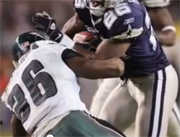- Navigating Your Midlife Crisis: Embracing New Possibilities
- City Raccoons Showing Signs of Domestication
- Mapping the Exposome: Science Broadens Focus to Environmental Disease Triggers
- One Week Less on Social Media Linked to Better Mental Health
- Your Brain Changes in Stages as You Age, Study Finds
- Some Suicide Victims Show No Typical Warning Signs, Study Finds
- ByHeart Formula Faces Lawsuits After Babies Sickened With Botulism
- Switch to Vegan Diet Could Cut Your Greenhouse Gas Emissions in Half
- Regular Bedtime Does Wonders for Blood Pressure
- Dining Alone Could Mean Worse Nutrition for Seniors
Can High Altitudes Protect Football Players From Concussions?


Pro football players are about one-third less likely to suffer concussions when playing at higher altitudes, a new study suggests.
The researchers also found that new helmet designs and rule changes have not done much to reduce concussions in the NFL.
They analyzed data gathered during the NFL regular seasons in 2012 and 2013, and found that players’ risk of concussion was 30 percent lower when they played in the nine league cities with the highest altitudes, ranging from about 650 feet to about 5,200 feet above sea level.
The cities included Atlanta, Buffalo, Charlotte, Denver, Indianapolis, Kansas City, Minneapolis Phoenix and Pittsburgh.
The researchers said many concussions in football players are believed to be caused by so-called “brain slosh.” The brain doesn’t fit tightly inside the skull, and is damaged when it moves around violently as a result of a hit to the head.
But higher altitudes cause increased blood flow to the brain, which makes it fit more tightly inside the skull. This reduces the risk of concussion, said the authors of the study, which was published recently in the Journal of Orthopaedic and Sports Physical Therapy.
Although the study found an association between altitude and concussion risk, it did not prove a cause-and-effect link.
“If we’re going to solve this problem, we have to figure out a way to protect the brain from the inside out,” study author Greg Myer, director of sports medicine research at Cincinnati Children’s Hospital Medical Center, said in a center news release. “That’s why we think we might be on the front edge of something that could influence a paradigm shift in concussion-prevention strategies.”
Myer and his colleagues also said new helmet designs and rule changes have not reduced NFL players’ concussion risk.
“Our brains already have a natural protective shield. Our skull is the brain’s natural helmet,” Myer said. “What modern helmets do very well is protect our skulls from fractures and lacerations.”
“The concept of adding more weight and padding to a helmet … can create more acceleration and leverage on the head, which can increase the risk of injury,” he said. “From a physics perspective, helmet designs do not appear to offer effective solutions to prevent concussions. You’re still going to have the brain sloshing inside the head.”
“We’re exploring approaches where we might be able to protect the brain from the inside out,” Myer said. “The question we need to answer is whether or not there is a way we can do this.”
More information
The American Academy of Family Physicians has more about concussions.
Source: HealthDay
Copyright © 2025 HealthDay. All rights reserved.










